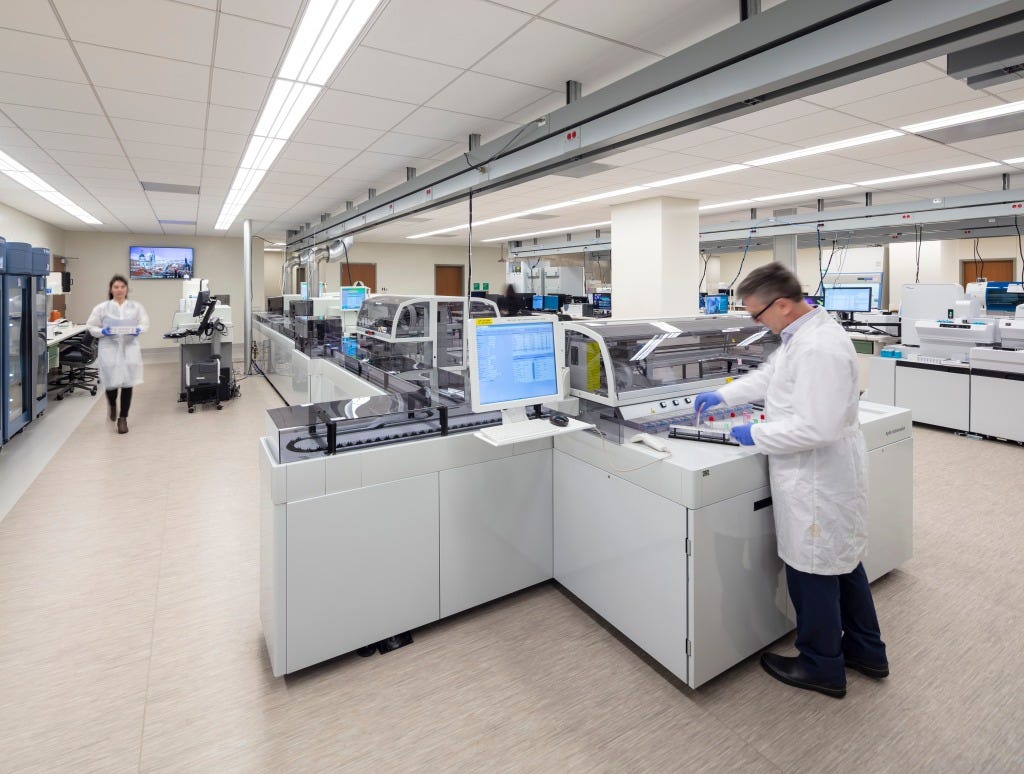The burgeoning awareness among individuals regarding health checkups is propelling The demand for advanced in vitro diagnostics, a method at the forefront of detecting health issues. Analyzing blood and urine samples and conducting meticulous diagnoses in laboratories with advanced automation and instruments, coupled with quality controls and assurance software, is becoming integral to diagnostic operations.
In Vitro Diagnostics Market Growth

1. Advanced Automation and Instruments
The global in vitro diagnostics market is poised for robust growth, projected to thrive at a steady Compound Annual Growth Rate (CAGR) of 4.8% from 2023 to 2033. As of 2023, the market boasts a substantial share of US$ 81.3 billion, and expectations are high for it to surpass US$ 129.9 billion by 2033. This growth is fueled by increasing awareness among individuals about the importance of health checkups and the rising demand for advanced in vitro diagnostics, a contemporary method for detecting health issues.
2. Convergence of Biotechnology, Laboratories, and Diagnostic Technology
The future of in vitro diagnostics is intricately linked to the seamless convergence of biotechnology, laboratories, and diagnostic technology. This integration is expected to fortify and secure the future of the in vitro diagnostics market. The paradigm shift from traditional diagnostics to advanced gene-level diagnostics is indicative of a significant leap in the industry.
3. Rise of Point-of-Care Testing
Well-established technologies like lateral flow strips and immunosensors, coupled with downsizing circuits and improved computational capacity of devices, have propelled the shift from centralized to point-of-care testing systems. This shift is anticipated to drive the demand for in vitro diagnostics, especially with the increasing prevalence of chronic diseases that necessitate regular health market monitoring.
4. Technological Advancements: Genetic Testing, Molecular Diagnostics
Modern technologies such as genetic testing, molecular diagnostics, Polymerase Chain Reaction (PCR), and next-generation sequencing (NGS) are becoming integral to the in vitro diagnostics platform. This incorporation of cutting-edge technologies is facilitating more precise and efficient diagnostic procedures. As companies introduce products with enhanced features, the in vitro diagnostics market is poised to thrive at a CAGR of 4.8% over the next decade.
The Path from History to the Future: A Comparative Analysis
From 2017 to 2022, the global in vitro diagnostics market registered a higher CAGR of 5.9%. The surge in chronic and infectious diseases during this period drove the increased usage of in-vitro diagnostics medical devices. The rising prevalence of chronic diseases necessitated extensive diagnostic procedures, fueling market growth.
The current in vitro diagnostics market Analysis remains positive, marked by the adoption of modern technology. A transformative shift has occurred, with traditional diagnostics giving way to gene-level diagnostics. The incorporation of technologies like genetic testing, molecular diagnostics, PCR, and NGS is contributing to this shift. Enhanced features in new product introductions are expected to drive sales and sustain a CAGR of 4.8% between 2023 and 2033.
Primary Dynamics Shaping the Market
1. Aging Population and Rise of Age-Related Ailments
As the global elderly population grows, the frequency of age-related ailments is predicted to rise significantly. Biomarkers, with their clinical value, are gaining prominence for disease screening, treatment, and medication.
2. Biomolecular Tools and Condition-Specific Tests
The accessibility of biomolecular tools and the integration of biomarkers are anticipated to give rise to condition-specific tests, introducing new in vitro diagnostics products.
3. Fierce Competition and Rapid Technological Advancements
The in vitro diagnostics industry is characterized by fierce competition. Competitors are focusing on maintaining their presence through research and development, fostering innovation with automation, Artificial Intelligence (AI), and advanced data analytics.
4. Automation to Meet Changing Demand
To meet the evolving demand from clinical laboratories and point-of-care diagnostic centers, companies are automating diagnostic testing. The introduction of quick Proof of Concept technology has streamlined workflows and reduced personnel requirements.
5. Collaborative Efforts for Public Health
Diagnostic testing and laboratory industries are collaborating to aid public health efforts, provide data for testing, and develop new transformative diagnostic technologies.
Market Challenges: In Vitro Diagnostics Market

1. Reimbursement Challenges
Countries with unfavorable reimbursement scenarios face issues in their financial systems due to continual technological advancements in medicine. Changes in reimbursement systems, especially in countries like the United States, can impact the molecular and genetic testing market, affecting overall market growth.
2. Operational Challenges in Clinical Laboratories
Clinical laboratories, especially in key markets, are grappling with operational challenges in sample procurement, storage, and transportation. The adoption of new technologies like Next-Generation Sequencing (NGS) and lab-on-a-chip PCR machines poses challenges in modifying laboratory space, driving up operational costs.
In conclusion
The in vitro diagnostics market is on a trajectory of steady growth, driven by technological advancements, changing demographics, and a paradigm shift in diagnostic approaches. As the industry embraces automation, AI, and cutting-edge technologies, the landscape is evolving to meet the demands of an increasingly health-conscious population.
Read Also:- In Vitro Diagnostics Market Size Unveiled: Trends and Insights